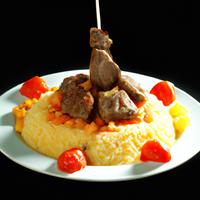
1 serving (200 grams) contains 350 calories, 20.0 grams of protein, 12.0 grams of fat, and 40.0 grams of carbohydrates.

Log this food in SnapCalorie

Nutrition Information
Calories |
411.8 | ||
|---|---|---|---|
% Daily Value* |
|||
| Total Fat | 14.1 g | 18% | |
| Saturated Fat | 4.7 g | 23% | |
| Polyunsaturated Fat | 0 g | ||
| Cholesterol | 58.8 mg | 19% | |
| Sodium | 470.6 mg | 20% | |
| Total Carbohydrates | 47.1 g | 17% | |
| Dietary Fiber | 2.4 g | 8% | |
| Sugars | 2.4 g | ||
| protein | 23.5 g | 47% | |
| Vitamin D | 0 mcg | 0% | |
| Calcium | 47.1 mg | 3% | |
| Iron | 2.9 mg | 16% | |
| Potassium | 352.9 mg | 7% | |
* Percent Daily Values are based on a 2,000 calorie diet. Your daily values may be higher or lower depending on your calorie needs.
Food Attributes
Source of Calories
About Lamb rice
Lamb Rice is a flavorful dish combining tender, seasoned lamb with aromatic rice, often enriched with spices such as cinnamon, cumin, and cardamom. Originating from Middle Eastern and Mediterranean cuisines, it is a hearty meal enjoyed in many variations worldwide. The dish typically includes ingredients like garlic, onions, and herbs, which add depth and health benefits, while some versions incorporate vegetables like carrots or peas for added nutrients. Lamb is a rich source of protein, iron, and zinc, supporting muscle health and immune function. However, as a red meat, it can be higher in saturated fat, making portion size and preparation method important considerations for a balanced diet. Rice, often used as the base, provides energy through complex carbohydrates, though choosing brown rice over white can enhance fiber content. Overall, Lamb Rice is a satisfying and nourishing dish when eaten in moderation.



